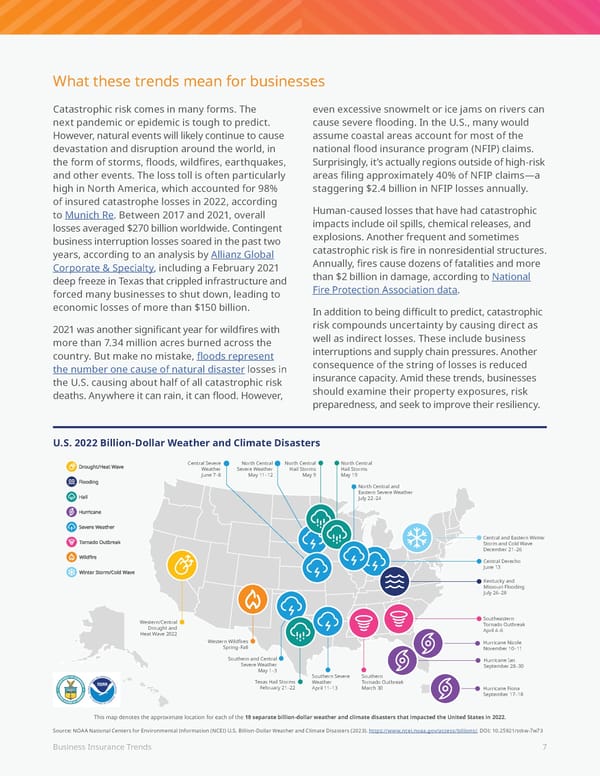What these trends mean for businesses Catastrophic risk comes in many forms. The even excessive snowmelt or ice jams on rivers can next pandemic or epidemic is tough to predict. cause severe 昀氀ooding. In the U.S., many would However, natural events will likely continue to cause assume coastal areas account for most of the devastation and disruption around the world, in national 昀氀ood insurance program (NFIP) claims. the form of storms, 昀氀oods, wild昀椀res, earthquakes, Surprisingly, it’s actually regions outside of high-risk and other events. The loss toll is often particularly areas 昀椀ling approximately 40% of NFIP claims—a high in North America, which accounted for 98% staggering $2.4 billion in NFIP losses annually. of insured catastrophe losses in 2022, according to Munich Re. Between 2017 and 2021, overall Human-caused losses that have had catastrophic impacts include oil spills, chemical releases, and losses averaged $270 billion worldwide. Contingent explosions. Another frequent and sometimes business interruption losses soared in the past two years, according to an analysis by Allianz Global catastrophic risk is 昀椀re in nonresidential structures. Corporate & Specialty, including a February 2021 Annually, 昀椀res cause dozens of fatalities and more than $2 billion in damage, according to National deep freeze in Texas that crippled infrastructure and Fire Protection Association data. forced many businesses to shut down, leading to economic losses of more than $150 billion. In addition to being di昀케cult to predict, catastrophic risk compounds uncertainty by causing direct as 2021 was another signi昀椀cant year for wild昀椀res with well as indirect losses. These include business more than 7.34 million acres burned across the country. But make no mistake, 昀氀oods represent interruptions and supply chain pressures. Another the number one cause of natural disaster losses in consequence of the string of losses is reduced insurance capacity. Amid these trends, businesses the U.S. causing about half of all catastrophic risk should examine their property exposures, risk deaths. Anywhere it can rain, it can 昀氀ood. However, preparedness, and seek to improve their resiliency. U.S. 2022 Billion-Dollar Weather and Climate Disasters Central Severe North Central North Central North Central Weather Severe Weather Hail Storms Hail Storms June 7–8 May 11–12 May 9 May 19 North Central and Eastern Severe Weather July 22–24 Central and Eastern Winter Storm and Cold Wave December 21–26 Central Derecho June 13 Kentucky and Missouri Flooding July 26–28 Western/Central Southeastern Drought and Tornado Outbreak Heat Wave 2022 April 4–6 Western Wildfires Hurricane Nicole Spring–Fall November 10–11 Southern and Central Hurricane Ian Severe Weather September 28–30 May 1–3 Southern Severe Southern Texas Hail Storms Weather Tornado Outbreak February 21–22 April 11–13 March 30 Hurricane Fiona September 17–18 This map denotes the approximate location for each of the 18 separate billion-dollar weather and climate disasters that impacted the United States in 2022. Source: NOAA National Centers for Environmental Information (NCEI) U.S. Billion-Dollar Weather and Climate Disasters (2023). https://www.ncei.noaa.gov/access/billions/, DOI: 10.25921/stkw-7w73 Business Business Business InsurInsurInsurance ance ance TTTrrrendsendsends 777
 2023 | Business Insurance Trends Page 7 Page 9
2023 | Business Insurance Trends Page 7 Page 9